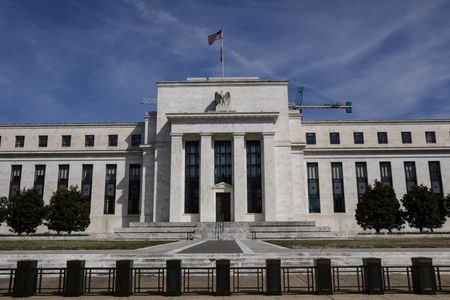By Jamie McGeever
ORLANDO, Fla. (Reuters) -“Don’t fight the Fed” is one of the most hallowed commandments in financial markets, but for most of this year traders and investors have ignored it.
It turns out that playing some Fed policy turn in 2023, rather than guessing any absolute peak rate itself, would have proven lucrative even in the face of constant Fed pushback about possible easing next year.
Even though 2022 will be one of the worst years on record for a range of assets from stocks to U.S. treasuries to corporate bonds, the damage was largely done in the first five and a half months of the year.
That was when, against a backdrop of surging inflation, the Fed’s original pivot to its most hawkish policy stance in decades took investors by surprise and markets crashed.
But since mid-May, when rates futures markets began to bet outright that the Fed would cut rates in the second half of next year, markets have stabilized. They are today pretty much where they were seven months ago, in some cases even a little higher.
To be clear, traders have not swum completely against the Fed. Rates futures have raised the 2023 implied fed funds terminal rate by 400 bps to around 5% and the Fed has raised its ‘dot plot’ forecasts, in a broadly lockstep move.
But since mid-May the implied 2023 terminal rate has been brought forward to the first half of the year, and rate cuts have been priced into the second half.
The dogged easing wager has remained even as implied futures pricing has accelerated, indicating that markets care more about the Fed pivoting than the actual level of rates.
DAZED…
Seven months ago the S&P 500 was just below 4,000 points, exactly where it closed on Wednesday; the ICE BofA high yield U.S. corporate bond index is now slightly higher; the ICE BofA aggregate Treasury index is down around 2%, and the dollar index is little changed.
Another way of putting it: since May, investors have not believed the Fed would be as hawkish as it says it would be. They have bet that the Fed would ultimately be forced to ditch its ‘higher for longer’ commitment and cut rates next year, and have traded accordingly.
That’s not to say markets would hold up in what is set to be a very sluggish economy next year. But for now a virtuous cycle between investor risk appetite and looser financial conditions is in play, despite the latest policy tightening and promise of more to come.
This suggests the Fed has a credibility or a communications problem. Or both.
“It was difficult for us to follow the logic of changes to the SEP and the Chair’s comments,” Morgan Stanley’s chief U.S. economist Ellen Zentner said, referring to policymaker’s Summary of Economic Projections and Chair Jerome Powell’s press conference.
Analysts at TD Securities were a bit more blunt.
“The market is calling the Fed’s bluff. Powell and co. can harp on a higher terminal and the need to keep it elevated all they want, but the market is trading and is focused on the next (easing) cycle,” they wrote on Wednesday.
…AND CONFUSED
The Fed’s messaging on Wednesday appeared a little confused.
Powell pushed back heavily on the idea that there would be any rate cut next year. Policymakers have raised their 2023 inflation forecast to 3.5%, and the median end-2023 fed funds rate outlook has jumped to 5.1%. All very hawkish.
Yet policymakers’ 2023 economic growth forecast has slumped to 0.5% – it was 2.25% in March – and they now see unemployment topping 4.5%. With inflation clearly cooling – incoming economic data aren’t looking too hot either – you can see why markets are putting the Fed’s hawkishness under intense scrutiny.
Powell’s comments are pushing Wall Street lower on Thursday, but interest rate markets largely have dismissed them and continue to price in more than 50 bps of rate cuts next year.
The battle lines are still drawn.
“The hawks may have come out to play, but markets continue to disobey,” said Investec’s Ellie Henderson, who along with Zentner at Morgan Stanley, expects the Fed to raise rates by only 25 bps in February before cutting in the fourth quarter.
(The opinions expressed here are those of the author, a columnist for Reuters.)
(By Jamie McGeever; editing by Diane Craft)

